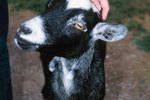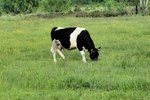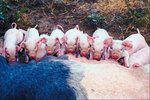
While you should always observe your livestock carefully, pay particular attention to the cow's appearance and behavior as her calving date nears. Between 6 percent and 10 percent of calves die at or soon after birth, according to the University of Missouri Extension. Approximately half of those deaths are due to calving difficulties, so it's important to be on hand to assist the cow.
Herd Separation
Cows in the early stages of labor usually want solitude. When a pregnant cow soon due to calve separates herself from the herd, that's a good indication the calf is on the way. She might also seem uncomfortable, kicking, switching her tail and appearing restless. Some cows repeatedly lie down and get up again. Many cows lose interest in eating.
Physical Changes
As parturtition nears, the cow's hips beginning widening in preparation -- you'll notice the base of her tail sinking. If your cow isn't too fat, you'll notice the the loosening of the pelvic ligaments, but that's not necessarily apparent in very heavy cows. The fetus moves backward, so the cow's belly shape alters. While udder filling can indicate that calving is imminent, the udders of some cows -- especially first-time mothers -- swell up days or even weeks before delivery.
Vulvar Changes
During a cow's pregnancy, a cervical plug keeps the cervix closed, protecting the fetus. About two weeks prior to calving, the cervical plug starts dissolving and the cervix begins dilating. You might see this thick mucous plug falling out of the vulva. Don't confuse the heavy mucus plug's dissolution with the discharge prior to delivery. As birth nears, the cow's vulva become loose and swollen. When a clear, mucousy discharge appears, the calf is soon on the way.
Parturition
Calving takes place in three stages. The initial stage of calving, when many of these signs first appear, can last between two and six hours. Once the water bag breaks, the second stage -- the actual delivery -- begins. For a heifer, or first-time mother, normal delivery lasts about an hour. Experienced cows might deliver in as little as a half-hour. If a heifer is still in labor after two hours, or a cow after an hour, call the vet. The third stage, expelling the placenta, should occur within 12 hours postpartum. If the complete placenta isn't out in that time, contact your vet.
References
- The Cattle Site: Assisting the Beef Cow at Calving Time
- Oklahoma Cooperative Extension Service: The Three Stages of Parturition
- Clemson University: Cattle -- Parturition
- The Rural: Signs That a Cow Is Calving (Parturition)
- University of Nebraska: Know the Signs of Impending Calving in Cows or Heifers
Photo Credits
-
Digital Vision./Digital Vision/Getty Images
Writer Bio
Jane Meggitt has been a writer for more than 20 years. In addition to reporting for a major newspaper chain, she has been published in "Horse News," "Suburban Classic," "Hoof Beats," "Equine Journal" and other publications. She has a Bachelor of Arts in English from New York University and an Associate of Arts from the American Academy of Dramatics Arts, New York City.




